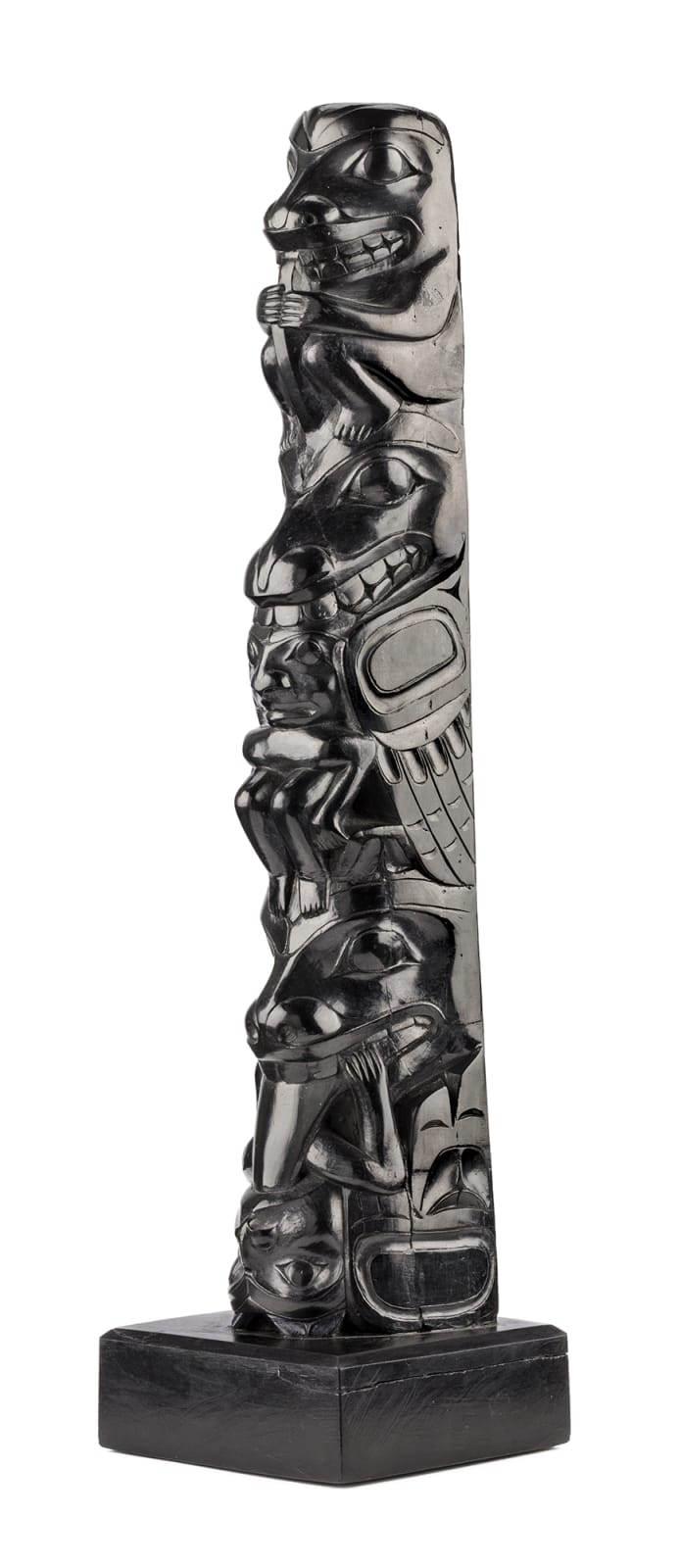UNIDENTIFIED ARTIST, HAIDA
Model Totem Pole, c. 1890-1910
argillite, 13.75 x 3.5 x 3.5 in (34.9 x 8.9 x 8.9 cm)
unsigned.
LOT 72
ESTIMATE: $15,000 — $25,000
PRICE REALIZED: $10,800.00
unsigned.
LOT 72
ESTIMATE: $15,000 — $25,000
PRICE REALIZED: $10,800.00
Further images
This model illustrates an intermediate step in the evolution of argillite totem poles though the latter decades of the nineteenth century, during which such models ceased to be based on...
This model illustrates an intermediate step in the evolution
of argillite totem poles though the latter decades of the
nineteenth century, during which such models ceased to
be based on the forms of full size Haida cedar poles and took on
proportions and sculptural characteristics of their own. This pole is
still slightly hollowed out and about as wide as it is deep, but by
1900 the backs of these models were flat, while their cross-sections
changed from being wider than the depth to much deeper than
the width. This enabled the figures to fill their own space, unhindered by the volumetric limitations of a cedar half-log.
Three primary figures make up the length of his pole, with two
smaller subsidiary figures overlapping and incorporated into the
forms of the main three. At the top is a humanoid figure with a
mammal-like snout, its hands grasping a dorsal fin-looking element
extending up between its knees. Its feet rest on the eyebrows of a
bear-like head also with a toothy snout. This figure sports a pair of
large wings, made up of big ovoids and layered feathers, though
the head is not apparently that of a bird. Captive between these
wings with its head caught in the snout is a small human figure
crouched in what is often called the hocker position, its feet resting
on the forehead of the bottom figure. That lower head is very like
a bear, with small short ears, long snout and many teeth. Its tongue
extends below to the upside-down face of a second subsidiary
figure, whose arms reach up with the hands grasping the bear’s
tongue. On either side of that figure we again see wing forms with
classic formline U-shapes flowing upward from a large ovoid that
rests on the thick base beneath the pole.
Steven C. Brown
References: For the section on argillite late model poles see Peter L. Macnair and Alan J. Hoover, The Magic Leaves: A History of Haida Argillite Carving (Victoria: Royal BC Museum, 1984/2002), pp. 127-138. See also Leslie Drew and Douglas Wilson, Argillite: Art of the Haida (Vancouver: Hancock House, 1980), pp. 216-227.
Steven C. Brown
References: For the section on argillite late model poles see Peter L. Macnair and Alan J. Hoover, The Magic Leaves: A History of Haida Argillite Carving (Victoria: Royal BC Museum, 1984/2002), pp. 127-138. See also Leslie Drew and Douglas Wilson, Argillite: Art of the Haida (Vancouver: Hancock House, 1980), pp. 216-227.
Provenance
Sotheby's Parke, Bennet, July 1981;A Toronto Collection;
Acquired form the above by the present Private Collection, Toronto, 2014.
Join our mailing list
* denotes required fields
We will process the personal data you have supplied in accordance with our privacy policy (available on request). You can unsubscribe or change your preferences at any time by clicking the link in our emails.












